September 26, 2016
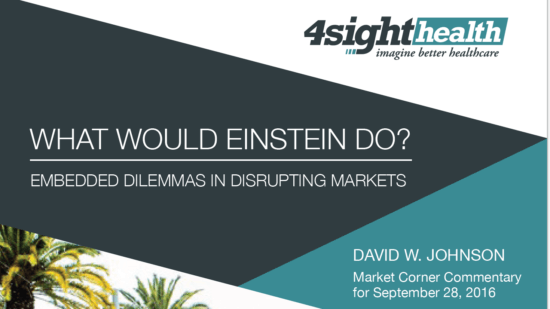
What Would Einstein Do? Embedded Dilemmas in Disrupting Markets
Earlier this month, Ford CEO Mark Fields made two head-scratching announcements to advance transportation services in San Francisco. Ford acquired Chariot, a popular crowd-sourced shuttle-van service that uses algorithms to adjust routes and increase transit efficiency in real time. The company simultaneously announced a partnership with Motivate, the nation’s largest bikeshare company, to implement a 10-fold expansion of the Bay area’s bikeshare program under the “Ford GoBike” banner.
These initiatives are part of Ford’s far-sighted repositioning of itself as a “mobility” company. Ford will employ multiple transportation services and smartphone technology to get customers where they want to go when they want to go there at low prices. Ford plans to expand its mobility platform to 5 additional cities by early 2018.
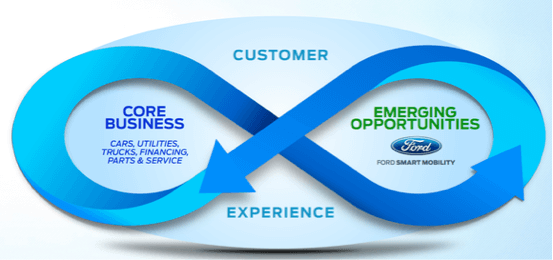
Driving isn’t cool anymore. Consumers are buying fewer cars. Millennials prefer the convenience and low-costs of carpooling, ride-sharing and inter-connected transit networks. These purchasing trends will accelerate as driverless cars become operational. In Ford’s disruptive new future, new competitors are everywhere (see chart below[1]). They include Google, Uber, Tesla and even Hertz. This is great news for consumers as more companies compete for their transit business.
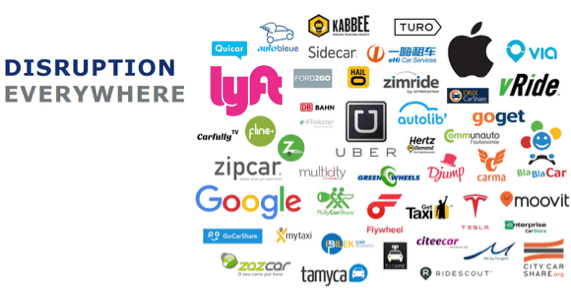
Consumers aren’t buying cars like they once did, preferring the convenience and low-costs of carpooling, ridesharing and inter-connected transit networks. This trend will accelerate as driverless cars become operational. In Ford’s brave new future, its competitors include Google, Uber and Tesla as well as General Motors, Toyota and Volkswagen.
New market realities create profound strategic dilemmas and raise existential questions. In healthcare’s brave new future, it’s vitally important to engage customers and provide them the services they want on their terms at affordable prices.
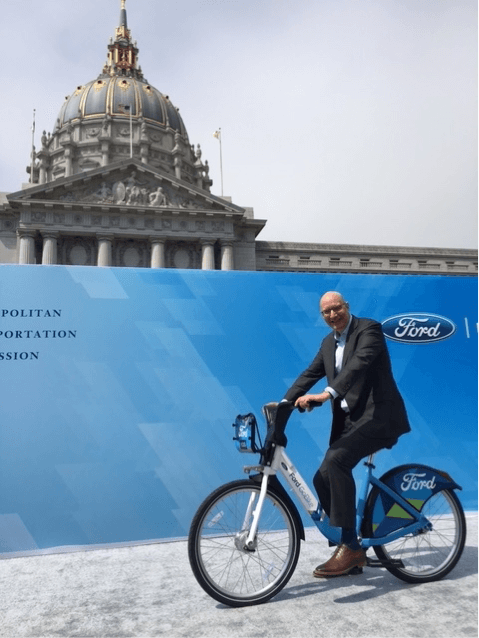
Ford’s Better Idea
Motivate CEO Jay Walder (pictured above) believes America is in the midst of a “transportation revolution.” He should know. The former New York MTA Chairmen left big transit last year to join his small, venture-funded bikeshare company.
Walder notes that customers experience traditional transit services on transit systems’ terms. They travel to and from subways, buses and trains to make trips. Old transit is inconvenient and time-consuming.
New transit engages customers on their terms through convenient access and egress. It is fast, convenient, cheap and empowering. Motivate’s press release enthusiastically describes the convenience and value Ford and Motivate will create for Bay-area transit customers,
“Ford Motor Company and Bay Area Motivate are working together to bring a bigger, better bike share to the Bay Area. With 7,000 bikes at full build-out, the system will have stations every few blocks in San Francisco; connect Oakland, Berkeley, and Emeryville; and extend the San Jose service area from the downtown core. It will link people to MUNI and BART, to jobs and schools, and all that the Bay Area has to offer.”
Unlike other bike rideshare programs (e.g. CitiBike in New York City and DivvyBike in Chicago) San Francisco’s Ford GoBikes will have telemetry and interconnect with the Chariot shuttle vans. Ford will use the crowd-sourced data it collects to design smarter transit routes and serve customers better through its mobile apps.
Jim Hackett is the CEO of Ford Smart Mobility LLC, the subsidiary Ford created to “design, build, grow and invest in emerging mobility services.” In a Motley Fool article, readers can sense Hackett’s passion for Ford’s integrated transit eco-system,
Telemetry is a form of communication, so now the bike is pinging data to us. Listen, here’s the deal. The opportunity is not bikes. That’s not why Ford’s in it. The opportunity is data, and the data is super valuable because it tells us these invisible paths that people are taking in this complex city [San Francisco] in terms of how they want to get around. And there’s something else cool about it because we can take that data and we can connect it in ways that our new shuttle is going to connect to the cloud as well.
In the following slide from Ford’s September 14th investor presentation, Hackett displays the emerging market potential and millions of customer connection points for his Smart Mobility division.
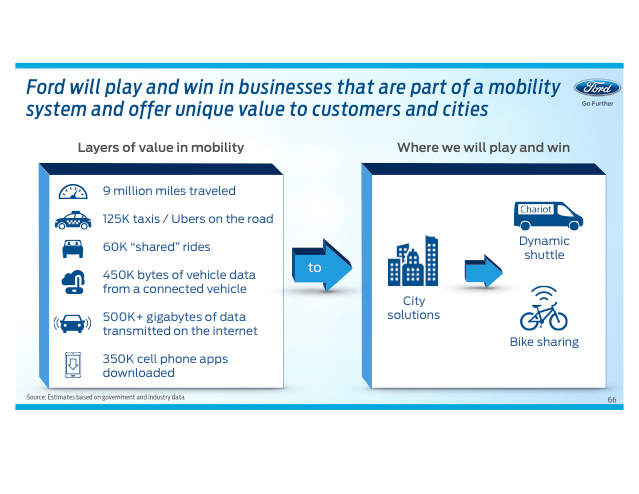
Ford Mobility also will be good for Ford shareholders. Hackett projects 20% operating margins, two-and-a-half times the 8% margins it makes on vehicle production and financing.
Imagine how health systems could advance community health and wellness if they pursued bold Ford-like business models to reposition themselves as true health companies. As W. Edwards Deming has observed, “Doing something new requires giving up something old.” Like Ford, health systems confront profound dilemmas as they transition in their future states.

What Would Einstein Do?
Like the late Yogi Berra, Albert Einstein had many quotable observations. Here’s one of his most famous, “The definition of insanity is doing the same thing over and over and expecting different results.” The American healthcare system already wastes a trillion dollars annually and delivers mediocre results. As Steve Jobs might say, it’s time for America’s health companies to “think different.”
Health systems confront strategic dilemmas. By definition, dilemmas have no inherent solutions. They require organizations to manage through the tensions created by opposing values: e.g. between mission and margin; between scale and complexity; between institutional control and community value. In his book No Problem,[1] Alex Lowy characterizes dilemmas as follows:
Dilemmas direct you to the heart of the issue. Dilemmas take courage. Dilemmas involve trade-offs and accommodation. Dilemmas are transformational; when you recognize and acknowledge an essential conflict, you open yourself to the possibility of needing to modify, resolve or redefine the terms of engagement.
Like Ford acknowledging declining vehicle sales, health systems must understand that current business models do not meet customers’ evolving needs. They need to retool operations to advance population health and build healthier communities. They must reconfigure their facilities to lower costs, increase convenience and reduce care variation. They must connect with customers on their terms.
Like Ford, health systems will require strategic partners to pivot, stay profitable and combat nimble new competitors. Google and Uber have their sights set on healthcare as well as transportation.
These are not easy challenges. It’s entirely appropriate to ask, “What would Einstein do?” Here are some suggestions from the great man himself:
“We cannot solve our problems with the same thinking we used when we created them.”
“To raise questions, new possibilities, to regard old problems from a new angle, requires creative imagination and marks real advance in science.”
“You have to learn the rules of the game. And then you have to play better than anyone else.”
“Once we accept our limits, we can go beyond them.”
“Strive not to be a success, but rather to be of value.”
Einstein’s observations go to the heart of the issue. Resolving healthcare’s strategic dilemmas requires strategic clarity regarding organizational purpose and priorities. It takes astute leaders exploiting disruptive tensions to align historic operating profiles with today’s operating realities. In post-reform healthcare, most high-cost business models aren’t sustainable.
Embracing value-based care delivery is essential for success. Easier said than done. The dilemma lies in transforming current organizational cultures and business models into high-performing, value-driven, customer-centric care companies. It’s adapt or die time for incumbent health companies. The competition has sharp horns and relentless energy.

Existential Questions
Admiral James Stockdale was Ross Perot’s running mate on the 1992 independent ticket. His opening statement at the Vice Presidential debate was: “Who am I? Why am I here?”[2] That line generated a huge laugh and immediate connection with the large viewing audience.
Unfortunately, Stockdale’s opening quip was the high point of his debate. It went downhill fast from there. However, the Admiral’s two questions synthesize a basic truth: businesses (and politicians) must offer value to customers (and constituents) to win.
As healthcare’s supply-demand relationships reconfigure, health companies must adapt their business models to provide value to customers. They must ask themselves the following tough existential questions:
- What businesses are we in?
- What are our competitive advantages?
- Which risks should we own; which should we shift to others?
- Is our leadership and governance up for the challenge?
- Who are our customers?
- How well are we meeting their needs?
- Are we too dependent on fee-for-service reimbursement payments?
- How strong is our brand? What does it say about us?
- Do our operations square with our rhetoric? Do we both speak and live the truth?

Buddy, Can You Paradigm?
“Paradigm shift” is an overused term in business lexicon. Reagan-Bush-era OMB Director Richard Darman acknowledged this when he quipped “Buddy, can you paradigm?” while detailing the logic for Bush’s reversal of his “Read my lips. No new taxes” pledge.
As President Bush discovered, shifting paradigms create profound dilemmas and can have dire consequences. Health systems confront a massive and unpredictable paradigm shift encompassing value-based service delivery. It is reconfiguring the competitive landscape. As in transportation, there’s a healthcare “revolution” underway in America. During revolutions, existential questions demand answers.
Winning health companies will answer these existential questions by executing disruptive strategies that delivering value to customers. No company is good at everything. To thrive in the post-reform marketplace, companies must determine where they excel and can execute “better than anyone else”.
This requires skillful leadership, enlightened governance and the willingness to confront core operating dilemmas. A hard and inconvenient truth is that most health systems act more for the benefit of clinicians than patients. Scheduling is difficult. Service delivery is inconsistent and fragmented. Customer experience is an afterthought.
Businesses cannot exist without customers. Ford understands this and is moving boldly to create new service platforms that meet customers’ evolving transportation needs. Health systems are learning this imperative truth slowly. They have thrived for decades by executing transactions without customers under fee-for-service payment: patients visit doctors and receive treatments while a third-party pays the bills.
Fee-for-service payment still dominates, but its days are numbered. Passive consumers are energizing. New business models are emerging to attack system inefficiencies and give customers the services they want. Government and commercial payers are demanding more value for their healthcare expenditures.
Following Einstein’s advice, it’s time for health systems “to play the new game” and “strive for value.” The “new game” requires true alignment with patients – meeting their health needs on their terms. Its mantra is outcomes matter, customers count and value rules.
[1] January 11, 2016 Presentation by Mary Barra, General Motors Chairman and CEO, at Deutsche Bank’s “Global Auto Industry Conference”
[2] Alex Lowy, No Problem, AuthorHouse™, 2007
[3] http://www.nytimes.com/1992/10/14/us/the-1992-campaign-james-stockdale-reluctant-politician-tempers-professional-edge.html





